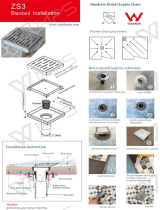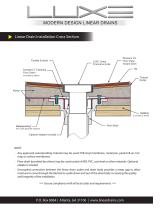
The Schluter
®
-Shower System is an integrated family of products
that improves on the traditional system by simplifying tiled shower
installations.
The process begins with the installation of solid backing
panels (e.g., gypsum panels or tile backerboards) on the
walls and either a sloped mortar bed or the prefabricated
KERDI-SHOWER-ST shower tray on the floor. These materials
provide the support for the waterproofing system and the tile.
Now the waterproofing application begins. The KERDI-DRAIN
is installed on top of the mortar bed or the shower tray. Then
the KERDI waterproofing membrane is bonded to the surfaces
of the walls and base, including the KERDI-DRAIN. The
KERDI-DRAIN features a large, integrated bonding flange that
ensures a secure connection to the KERDI waterproofing
membrane. Unlike the waterproofing materials used in the
traditional system, tile can be set directly on the KERDI membrane
using thin-set mortar.
This is what makes the Schluter
®
-Shower System unique. The
waterproofing system is installed on top of the backing materials
rather than below. This eliminates the potential for moisture to seep
into the mortar bed or the tile backing on walls, and thus allows the
tile covering to dry between uses. The integrated Schluter
®
-Shower
System eliminates leaks, reduces the potential for efflorescence
and mold growth in the system, and dramatically reduces total
installation time to ensure success and make shower installation
easier than ever.
Schluter
®
-KERDI waterproofing membrane
Integrated
bonding flange
Sloped mortar bed or
prefabricated foam tray
The Traditional System
Pan liner method
Weep holes
Pre-slope
Pan liner
Mortar bed
Moisture barrier
Waterproofing is the foundation of a successful tiled bathroom. Moisture-sensitive construction materials such as wood framing, plywood
or OSB sheathing, gypsum wallboard, etc. must be protected from water and vapor penetration. Wet areas increase the potential for
mold growth if effective moisture management is not provided. The key to mold control is moisture control.
The traditional method for installing tiled showers is both time
and labor intensive, requiring many steps to ensure success.
First, a mortar bed is sloped to the weep holes in the drain. The
waterproofing membrane, called a pan liner, is placed over this
“pre-slope” and clamped into the drain. The pan liner is carried
over the curb and up the walls about 3 inches above the curb. A
moisture barrier, such as tar paper or plastic sheeting, is placed
on the walls and lapped over the pan liner.
While this completes the waterproofing installation, additional
prep work is required because the waterproofing materials
used in this system do not allow for the direct application of
tile. A mortar bed is placed over the pan liner, and the walls are
covered with mortar or tile backerboard. These materials provide
a support layer and bonding surface for the tile.
Contrary to popular belief, the tile covering itself is not
waterproof. When the shower is in use, water and vapor
will penetrate the mortar bed and tile backing on the
walls. This moisture must seep through the mortar bed
to the sloped pan liner and exit through the weep holes
in the drain. In this way, the assembly can be described as a
“water-in/water-out” system.
With regular use of the shower, the mortar bed can remain
soaked, particularly if the pre-slope installation is ignored or the
weep holes in the drain become clogged. With no way to escape,
the water will continue to build up. The continued presence of
moisture increases the potential for efflorescence and mold
growth within the system.
The Traditional Shower vs. the Schluter
®
Shower
Schluter
®
-Shower System
Bonded waterproofing

















